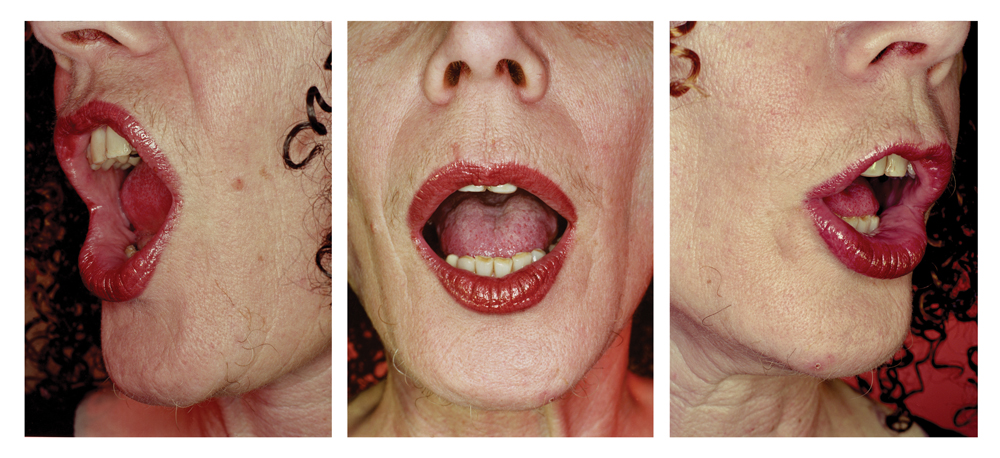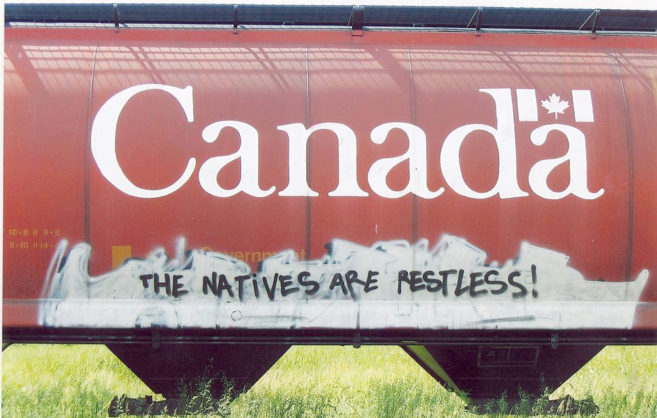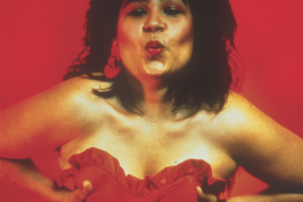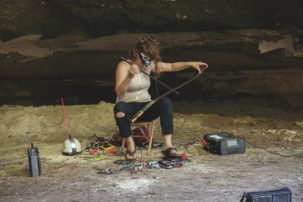Questions of age are, in many respects, also questions of perspective. In a culture and an art world that often can be preoccupied with “the next big thing,” it’s all too easy to lose sight of the artists, the issues and the debates that were—and continue to be—critical in paving the way forward. It’s a discussion taken up here by veteran artists Jamelie Hassan and Richard Fung, and independent curator Ryan Rice, whose deep histories and active engagements with art practices across generations offer a clear view of where we’ve been and where we need to go next.
Bryne McLaughlin: How would you define ageism, specifically in an art world context?
Jamelie Hassan: I guess in some ways I don’t really spend much time thinking about my age. I have a strong attachment to intergenerational practice, and because of my social relations within that context, I’m constantly learning in different ways from older and younger people. I grew up in an intergenerational family, so the notion of age, or ageism, doesn’t really enter into my own philosophical approach to my practice.
Ryan Rice: I haven’t really spent much time thinking about age either, except for how it’s used against you when you are considered as an “emerging” artist rather than “established” or “mid-career.” You’re not really able to establish yourself as a professional artist in Canada until you turn 30. You can access some types of grants, but they are mostly for training or internships, not for a professional practice. When I was granted the Canada Council’s Aboriginal Curatorial Residency in 2005, for example, people would always undermine it by saying, “Oh, you’re doing an internship.” I’d always have to correct them by explaining it’s a residency, a practice. And for many years, I was always referred to as a “young curator” because I was independent. It wasn’t until I got a full-time curatorial job that the “young” label was dropped.
Richard Fung: When I think of ageism I think of it in the framework of discrimination. I’ve seen it happen, not necessarily in the art world but in a general context in which you are dismissed for being too young and not having enough experience, or too old and irrelevant. It’s interesting to see that museums in the US are now “discovering” older artists, women in particular. It can become a trend. I remember in the 1980s and ’90s when the British Black Art movement came forward and there was this focus on “multiculturalism” in the US, and all of a sudden interest turned to other types of artists, whether they were queer, people of colour, etc. In the Canadian context, this interest centred on debates about cultural appropriation. There began to be a focus on who was producing work, who the audience was, what the work was speaking about—all of that was part of the Canada Council’s equity process in the early 1990s. Because of those kinds of institutional changes, there was also a shift in who was getting funding and getting shown, for a while.
What also interests me in thinking about art in terms of a career is that there are not that many of us who have managed to be able to produce a long-term career. Teaching has allowed me to maintain an economic bottom line, and to have a certain amount of freedom in what I do. But for most artists it’s very hard to sustain a career. You see that affecting people of colour and Indigenous artists, for example. There are very few non-white artists who are able to sustain a career for that long. That plays out in who gets shown, collected, etc.
RR: I would add that funding structures have also contributed to ageism. The model used to be emerging, mid-career and established, and the people who measured these categories on peer juries would assume that an emerging artist is a young person, and that the rest fall within brackets of age. That has sort of changed now. But I think the perception is still out there. Peer juries are still going back to those types of systems where they’re advocating for who fits in where based on age. I think this is a decolonizing exercise that we might have achieved to some extent, and new people with different ideas are coming to the table now on juries, among other changes.
BM: So where intergenerational dialogue exists, how do you make that transfer of knowledge most meaningful?
RF: Maybe we could use the term “exchange” instead of “transfer.” In my teaching experience it’s much more of an exchange. The art world has shifted from the time when I was doing a lot of work, and it keeps shifting. One course I’m teaching now, which was developed by the late Wendy Coburn, is called Making Gender: LGBTQ Studio, and it’s apparently the first studio course focusing on these issues in North America. Again, it’s not about transferring knowledge because trans identities and non-binary identities keep shifting. As one gets older it becomes more and more important to be in conversation with younger people and to be open to new ideas, and not imagine that everything that you were taught when you were young still holds.
JH: I’ve been really involved in working with students around my archive. Because of the students’ curiosity in this specific period of time or that particular project, it gets me thinking, Oh, wow, I really do have a lot of material that is pre-internet, documents that I should share. The critical question is, How does the archive function in a larger sense? Right now there’s no model for us, no funding. The challenge is finding institutional spaces for these archives and looking for more modest ways of maintaining and sharing knowledge. Do either of you feel the same urgent need to protect the archive as I do?
RF: I am committed to the archive in general, though perhaps less so with my own. But if I could just redirect the focus a little bit, I think that there has been a lot of interest among younger people in terms of the different struggles that have taken place and the lack of access they have to these stories. That’s where institutions come in. That’s where you have an ability to ensure that these stories get passed on.
RR: One really important thing regarding the archive is the idea of open access. We have the technology to share and there needs to be a way to provide access because histories are starting to get repeated. People are starting to create platforms to address the same issues we dealt with 30 years ago, 20 years ago, 10 years ago.… There is a lot of recycling going on because people aren’t informed and don’t know how to get informed. Even though social networking has to some extent collapsed this distance, there are still gaps. There’s also been a shift in how institutions function. The full-time, permanent curator doesn’t exist now in the same way it did in the past. So you have new people in these roles coming in and recovering the histories that were absent. I think that’s why a lot of older artists are being recognized today.
JH: Yes, absolutely. Crystal Mowry, curator at the Kitchener-Waterloo Art Gallery, recently worked with curator and artist Lisa Myers on the exhibition “Carry Forward,” which dealt with the idea of documentation and how we can engage with earlier works and histories. The exhibition was inspired by the work of the late video artist Mike MacDonald. A lot of people know of his work, but the opportunity to see it becomes rarer and rarer when you’re not around to advocate for showing your work. So these issues of how much time one has left on this earth [laughs] become more pressing with each passing year.
RR: I also think that there’s a responsibility within an artist’s career to try to partner with somebody who will agree to take on their estate. I encourage a lot of artists, if their work is too big or they can’t sell it, to donate it to a university art gallery or somewhere else where it can be cared for. At OCAD University right now, we have been gifted Duke Redbird’s archive, and we are tasked with making that accessible. There need to be collaborative relationships in terms of keeping art alive.
JH: That’s very true, and I think that a lot of senior artists are actively involved in that right now. But in tandem with that we also need to see the value associated with the work taken into account. If you keep a work around for a long time and it’s important to you, then of course you will make the moves to get it into an institution. I’ve done that with works from the 1980s. But I also think there’s a lot of emphasis on showing new work. So this idea of looking back at even a single installation work that might have been pivotal to your production, and getting it shown in a group exhibition that is intergenerational, is really important, as in the case of “Carry Forward.”
RF: Maybe it’s just in terms of the media arts, but I’ve found my older works are actually being circulated more in museum spaces, perhaps more widely than they did originally, because they’ve become old. There is an interest in looking back at histories, at periods when these works were seen as being one among many, or when museums maybe just weren’t interested in the work being done at that time. Now you can reframe things in an interesting way.
JH: I think it’s hysterical that there are people who ask an artist when they’re going to retire. [Laughs] There’s this general assumption that there’s a line at some point where, you know, you stop. Artists keep working as long as they can…it’s just what you do. The idea of retiring is definitely connected to the professional structure within an institution. When curators “retire” what do they do? Do they say, “Well, I’ve done enough, now I’m off”?
RF: It does become more difficult for artists to keep producing work if they are not selling or being shown. I’m thinking about artists I know who are in PhD programs, mostly because they can get some kind of funding that allows them to produce work. And these artists are most likely not going to get teaching jobs because they are at “retirement” age. So there is this question again of the sustainability of a career. It’s not even about the quality of the work, these are great artists.
JH: Yes. I guess in relation to this particular Western capitalist set-up that we have, it’s crucial to return to the concept within Indigenous cultures, as well as other cultures, that elders have something to offer, that there is a space within the institution for people who are knowledgeable and can be present to give encouragement and exchange in dialogue with people. For years, Trent University has had elders conferences, but at a certain point they fell out of touch in terms of what they were doing with the Native Studies department at the time. Most students who were in that program didn’t have a chance to actually dialogue with the elders, because the conferences became so important and significant to a larger public. I remember being at one of these conferences in the ’90s. We were all jammed into this lecture hall and one of the elders said, “There are too many people in the room.” Our idea of something being successful is a lot of people turning up. But maybe that’s not the way that meaningful exchange actually happens. When I’m giving a talk, I look around the hall to see who is the youngest person present. I want that person to know that I’m happy they are there, that their taking that time to be there means something to me. I think it’s really important that exchange with younger generations is meaningful.
BM: So, having access to the longer view of an artist’s practice helps a younger artist or curator position their work against past dialogues. There is a constant sense of rediscovery going on. At the same time, it’s nice when a senior artist’s new work is the entry point for understanding how that practice has developed over time. It dovetails that need for the archive to exist and be accessible, and for support structures for artists so they can continue making work. I’m curious, Ryan, in your curatorial work, how do you approach this idea of bringing practices back into circulation, bringing knowledge back into the conversation?
RR: Well, I guess it all depends on the premise of the exhibition. The recognition, acknowledgement and respect of past practices or people who have paved the path contributes a lot to contemporary exhibitions. It’s about levelling the playing field, bringing everyone within an equitable space, whether it’s emerging or established artists or in between, and creating a space for a community to come together. I do a lot of big group shows, so I’m always aware of who’s involved, where they are in their career, whether they’re male, female, gender fluid, queer, whether they are emerging or established. It’s a question of how do you bring these communities together. I think that builds the strength of what I try to do because I’m also recognizing who came before me and naming those practices, whether it’s 100 years ago or 20 years ago. It’s why I’m doing what I do, because of those past efforts. Time has collapsed, and that means age has collapsed as well. It situates us against a Western framework because it’s not compartmentalized within a certain genre, time period or framing of a practice and career. It challenges the canon. And I think we’re at a critical time in writing about these issues. What I wrote about 20 years ago, I’m still writing about today. The same issues. I just rewrote an article that I wrote 10 years ago. It is almost word-for-word what I experienced then. And in the context of 2018, it’s even more critical. So I think we’re all scrambling to write the histories that are there, but are not readily accessible. That comes down to the artwork, the archive and being able to see where those things are or where they exist.
JH: And then also connecting to those important collections that are being destabilized in various ways by contemporary artists and the issues of our time. Richard, you were talking about how it becomes more and more difficult to produce work if the work is just accumulating in your studio. I really appreciate that. What I can do more of is a visiting-artist situation, working in different cultures and communities, bringing back some, but not all, of the work that I have done there, because it’s a practice, a process and a method of sharing. As senior working artists, we can gift our networks and bring on enlightened collaborators who want to see this happen in their communities. That creates space for younger artists and activists. I think those are models that we need to look at.
This post is adapted from an article of the same title in the Spring 2018 issue of Canadian Art, which is themed on “Dirty Words.”

 Suzy Lake, Beauty at a Proper Distance/In Song #1, 2002. Three archival ink-jet prints, 1.77 x 1.27 m each. Courtesy Georgia Scherman Projects.
Suzy Lake, Beauty at a Proper Distance/In Song #1, 2002. Three archival ink-jet prints, 1.77 x 1.27 m each. Courtesy Georgia Scherman Projects.







